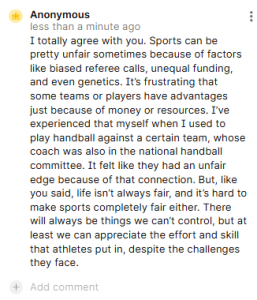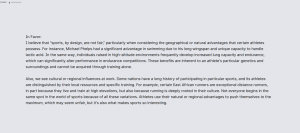2
Section One: The Fundamentals
A) History and Context
Exercise 1: Notebook Prompt
| I learned a lot of surprising information, some disturbing especially when Max was made to underdress, opeining her legs and testing by touching??? This happened in 2015, which is not really that long ago, and when Max said not even her mom did this, that was more disturbing to hear. I think this really angered me which I cannot fully express here. The experience made her feel humiliated and hurt. Later, she was told she had high testosterone levels and was not allowed to compete unless she changed her body by taking medication or undergoing surgery.
This only shows how gender testing in sports has caused harm for many years, and it is still a problem today. Something new I learned in this episode was how chromosomes were discovered from testing on cats. I learned that there are dark spots in the cell. This I believe was revolutionary for dna testing in general and probably in medicine world. As mentioned in the episode, I am at least glad that they moved from nude parades to Barr Body test, because I am still not okay learning about how they used to “check”. |
B) Timeline of History
Exercise 2: Notebook Prompt
What other significant case/milestone would you add to this timeline? Note it in your notebook along with a brief (one or two sentences) explanation of why you feel it is important.
| April 2011 New Policy on Hyperandrogenism in Elite Female AthletesUnder these rules, female athletes with naturally high testosterone levels above 10 nmol/L could not compete in the women’s category unless they could prove that their bodies did not respond to testosterone in a way that gave them an advantage. This marked a shift in gender verification policies, moving away from outright sex testing to a focus on hormone levels. The regulation was controversial, as critics argued it unfairly targeted intersex and Differences in Sex Development athletes, reinforcing historical patterns of exclusion. |
C) Gender coding in Sports
Exercise 3: Notebook Prompt
Has the gendering of sport ever been a constraint on your involvement? How?
Or, if not, why do you think this is?
|
Gender in sports has never stopped me from playing. As a boy, I always felt like I belonged in any sport I wanted to try. When I was six, I started roller skating and became one of the fastest in my country for my age. In my skating club, both boys and girls skated, but I never had to worry about whether I was supposed to be there. No one questioned if I should be skating just because I was a boy. I also played handball from age nine and got to travel for tournaments. I went to Nepal and played in big events like the Partille Cup in Sweden and Dronninglund Cup in Denmark, both from 2011 to 2013. I was always encouraged and judged based on my skill, not my gender. I never had to fight for my place in the sport. It was just normal for boys to play, compete, and get opportunities. Thinking about it now, I realize that girls may not always have the same experience. Some sports are seen as “for boys,” and girls might not be encouraged in the same way. It’s unfair that they might have to work harder just to be accepted in certain sports. I was lucky to always feel welcome, but it’s sad that not everyone gets that same chance. |
D) How is sport gendered in the popular imagination?
Exercise 4: Padlet/Notebook Prompt
While most sports are in fact unisex, gender coding remains pervasive, particularly at the professional level, although with a foundation established in youth competition. Participate in the poll below to share your views on how popular sports are gendered in the popular imagination. Also feel welcome to add or suggest sports that you feel strongly conform to the gender binary!
After you contribute to the padlet prompt, record your response in your notebook AND briefly discuss in two or three sentences how these responses and the polling figures in general confirm or contradict your assumptions about gender-coding and sports. Did anything surprise you?
|
Most of my expectations were confirmed, but a few results surprised me. For example, I thought softball was a more neutral sport, but the polling showed it was more female coded. This might be because softball is not commonly played in my country, so I did not have the same perspective as others. Similarly, I assumed hockey was neutral since it is popular among both men and women in my country, but the polls showed it was more male coded. One of the biggest surprises was soccer. I expected it to be strongly male coded because of how it originated. Soccer has deep historical ties to men’s teams and competitions, with professional leagues for men forming long before women had similar opportunities. However, the polls showed that soccer is now viewed as more neutral, which suggests that its perception has changed over time. Overall, while most results matched my expectations, these few differences made me realize how gender coding in sports can vary across different cultures and perspectives. I did have a few misclicks through the polls and there was not an option to change the answer so there is that too. |
Section Two: Breaking it down
A) Title IX
Exercise 5: Notebook Prompt
In a longer version of the interview excerpted in the video above, Leah Thomas states “Trans women competing in women’s sports does not threaten women’s sports as a whole because trans women are a very small minority of all athletes and the NCAA rules around trans women competing in women’s sports have been around for 10+ years and we haven’t seen any massive wave of trans women dominating”?
Do you agree with this statement? See also the image above suggesting that the issue may be overblown by politicians and influencers who don’t actually care that much about women’s sports.
Please share any thoughts you have in your Notebook by clicking on the audio button above or writing a few sentences.
|
I agree with what Leah Thomas said. There are very few transgender athletes, and the regulations governing their participation in women’s sports have existed for quite some time. They seem to be crying over an issue that is not really there, and I wonder how much of it just comes from personal hatred. There has not been a significant surge in transgender female athletes. Politicians and members of the media who have little interest in women’s sports seem to be the ones who talk about this topic the most. They would concentrate on issues like the pay disparity, insufficient funding, and limited possibilities for female athletes if they genuinely cared about equity. Talking about justice is vital, but we should keep the facts front and center and avoid letting propaganda take over the conversation.
|
B) Unfair Advantage?
Exercise 6: Notebook Prompt
What does the host and writer, Rose Eveleth, have to say on the issue of unfair advantage?
Can you think of other examples of unique biological or circumstantial advantages from which athletes have benefitted enormously that have nothing to do with gender?
| In the episode, Rose Evereth talks on how athletes can at times gain a “unfair advantage” due to inherent physical or environmental advantages rather than outside doping or cheating. For example, some athletes may naturally have advantages in their sport due to exceptional genetic features, such as longer limbs, improved lung capacity, or greater muscle recovery rates. This raises the issue of whether we should distinguish between biological characteristics and performance-enhancing technologies, as well as what unfair advantages are.
Many athletes have natural physical advantages that help them perform better in their sports. For instance, height and long limbs are a big advantage in sports like basketball and volleyball. Michael Jordan and LeBron James are both incredibly tall, which helps them reach higher, jump higher, and block shots. This gives them a clear advantage over shorter players. Another important part of sports like ballet and gymnastics is flexibility. One of the best gymnasts of all time, Simone Biles, is incredibly flexible, enabling her to do routines that others simply cannot. This makes her routines even more challenging and impressive. Similar to this, ballet dancer Michaela DePrince’s extraordinary flexibility enables her to execute challenging maneuvers with grace. Some athletes’ fast twitch muscle fibers make them naturally quick. For instance, Usain Bolt is known for being the world’s fastest sprinter. Fast twitch fibers in his body enable him to accelerate and maintain speed because they are designed for speed. These muscle fibers were also present in sprinter Florence Griffith Joyner, who utilized them to her advantage in competition. Training at high altitudes is another way athletes gain an advantage. Haile Gebrselassie, a famous long distance runner, trained in the mountains to increase his red blood cell count, which helped him perform better in races. These natural advantages play a huge role in helping athletes succeed in their sports.
|
Again, let’s turn to Katie Barnes who points out that we tend to forget amidst all the debate that “sports, by design, are not fair” (235), that “the reality of sports is that we accept unfairness all the time” (235).
Do you agree? Why? In your experience, how fair are sports? Feel welcome to add a video response in the padlet and provide an example if you’re willing. Make sure you include a screenshot of your response in your notebook.
 
The image might not be clear so I will copy paste below anyway: In Favor: I believe that “sports, by design, are not fair,” particularly when considering the geographical or natural advantages that certain athletes possess. For instance, Michael Phelps had a significant advantage in swimming due to his long wingspan and unique capacity to handle lactic acid. In the same way, individuals raised in high-altitude environments frequently develop increased lung capacity and endurance, which can significantly alter performance in endurance competitions. These benefits are inherent to an athlete’s particular genetics and surroundings and cannot be acquired through training alone. Also, we see cultural or regional influences at work. Some nations have a long history of participating in particular sports, and its athletes are distinguished by their local resources and specific training. For example, certain East African runners are exceptional distance runners, in part because they live and train at high elevations, but also because running is deeply rooted in their culture. Not everyone begins in the same spot in the world of sports because of all these variations. Athletes use their natural or regional advantages to push themselves to the maximum, which may seem unfair, but it’s also what makes sports so interesting.
|
B) The Paris Olympics
Optional Response:
What does Robins mean when she argues that:
“The aims of transvestigating an Olympic athlete are not, in any meaningful sense, anything to do with sports, or fairness, or even with women (cis women, at least) as a social category. Rather, they have everything to do with transness, and the public expression of transfemininity.
For my money this has never been about sport.
What it has always been is an excuse to publicly relitigate the existence of trans women.”
Make a note in your Notebook.
|
|


